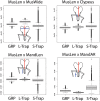Shifts in morphological covariation and evolutionary rates across multiple acquisitions of the trap-jaw mechanism in Strumigenys
- PMID: 35848877
- PMCID: PMC9545230
- DOI: 10.1111/evo.14557
Shifts in morphological covariation and evolutionary rates across multiple acquisitions of the trap-jaw mechanism in Strumigenys
Abstract
A long-standing question in comparative biology is how the evolution of biomechanical systems influences morphological evolution. The need for functional fidelity implies that the evolution of such systems should be associated with tighter morphological covariation, which may promote or dampen rates of morphological evolution. I examine this question across multiple evolutionary origins of the trap-jaw mechanism in the genus Strumigenys. Trap-jaw ants have latch-mediated, spring-actuated systems that amplify the power output of their mandibles. I use Bayesian estimates of covariation and evolutionary rates to test the hypotheses that the evolution of this high-performance system is associated with tighter morphological covariation in the head and mandibles relative to nontrap-jaw forms and that this leads to shifts in rates of morphological evolution. Contrary to these hypotheses, there is no evidence of a large-scale shift to higher covariation in trap-jaw forms, while different traits show both increased and decreased evolutionary rates between forms. These patterns may be indicative of many-to-one mapping and/or mechanical sensitivity in the trap-jaw LaMSA system. Overall, it appears that the evolution of trap-jaw forms in Strumigenys did not require a correlated increase in morphological covariation, partly explaining the proclivity with which the system has evolved.
Keywords: biomechanics; covariation; evolutionary rates; trap-jaw ants.
© 2022 The Authors. Evolution published by Wiley Periodicals LLC on behalf of The Society for the Study of Evolution.
Figures





Similar articles
-
Performance, morphology and control of power-amplified mandibles in the trap-jaw ant Myrmoteras (Hymenoptera: Formicidae).J Exp Biol. 2017 Sep 1;220(Pt 17):3062-3071. doi: 10.1242/jeb.156513. J Exp Biol. 2017. PMID: 28855320
-
Functional innovation promotes diversification of form in the evolution of an ultrafast trap-jaw mechanism in ants.PLoS Biol. 2021 Mar 2;19(3):e3001031. doi: 10.1371/journal.pbio.3001031. eCollection 2021 Mar. PLoS Biol. 2021. PMID: 33651798 Free PMC article.
-
Muscle fatigue in the latch-mediated spring actuated mandibles of trap-jaw ants.Integr Comp Biol. 2022 Jun 11:icac091. doi: 10.1093/icb/icac091. Online ahead of print. Integr Comp Biol. 2022. PMID: 35689666
-
Evolution of the vertebrate jaw: comparative embryology and molecular developmental biology reveal the factors behind evolutionary novelty.J Anat. 2004 Nov;205(5):335-47. doi: 10.1111/j.0021-8782.2004.00345.x. J Anat. 2004. PMID: 15575882 Free PMC article. Review.
-
Caste development and evolution in ants: it's all about size.J Exp Biol. 2017 Jan 1;220(Pt 1):53-62. doi: 10.1242/jeb.145292. J Exp Biol. 2017. PMID: 28057828 Review.
References
-
- Albrecht, G.H. , Gelvin, B.R. & Hartman, S.E. (1993) Ratios as a size adjustment in morphometrics. Am. J. Phys. Anthropol, 91, 441–468. - PubMed
-
- Anderson, P.S.L. , Claverie, T. & Patek, S.N. (2014) Levers and linkages: Mechanical trade‐offs in a power‐amplified system. Evolution; Internation Journal of Organic Evolution, 68, 1919–1933. - PubMed
